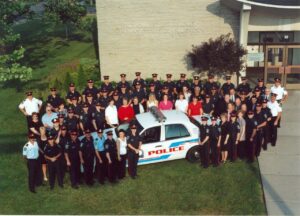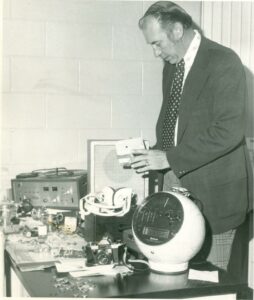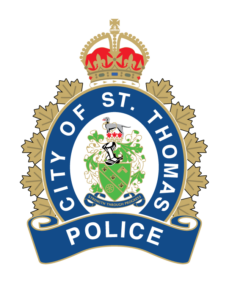
HISTORY
The Evolution of Policing in St.Thomas
The development of the St. Thomas Police Service has paralleled the growth and prosperity of the community it serves. Since the establishment of trade and commerce and the settlement of families in this area in the 1800’s, the community required the most fundamental and necessary element of society to thrive, that being, security and public order – the mainstay of any community that allows all other elements to flourish.
The establishment of our community stems back to 1804 when Colonel Talbot first settled in this area. Between 1809 and 1824, Talbot Road was built, businesses and trade were introduced, a Masonic Lodge, a Church and the first resident missionary was built. Individuals and families settled in the area and local government was elected. The nucleus of our community had been established.

Following British tradition, the responsibility for policing was delegated to Municipal Council who had the authority to establish and govern policing in the community. The evolution of our Police Force accompanied the advancements in local municipal administration. By 1852, when St. Thomas was incorporated as the Municipality of the Village of St. Thomas, the governing authorities passed a by-law appointing our first two Police Constables – Richard Willis and Robert Cusack. Since that time, the Police Constable has continued to be the consistent front-line connection with the community. To the present day, the Police Constable remains the nucleus of our organization with all other positions existing to support them in the delivery of services to the citizens. There have been many changes since 1852, yet the foundation of the St. Thomas Police Service has remained the same.
In 1888, Police Chief James Fewings published a book of rules and regulations based on the principles and goals held by Sir Robert Peel. Fewings’ book outlined the main objectives of “crime prevention, security of person and property, and the preservation of public tranquility” which are still pertinent today. His “Police Instruction Book” was the first written guideline for front-line officers which endured in practice for the next century. In the 1990’s, Adequacy Standards were introduced in Ontario to ensure the consistent delivery of a range of police services. The Adequacy Standards as set out in the Regulation under the Police Services Act connect the framework for the delivery of services in six core functions: crime prevention, law enforcement, victims’ assistance, public order maintenance, emergency response and administration and infrastructure. The Regulation requires Police Services and Boards to implement policies and procedures in compliance with the standards. Since then, the Police Services Boards have adopted policies in relation to these standards. In 2001, our Rules and Regulations were revised and modernized to address relevant community issues such as victim’s assistance, emergency response services and administration and infrastructure. The first Business Plan was introduced in 2001 encompassing the goals, objectives and planning for the next three years. Through consultation with the public, local organizations and businesses by means of community surveys as well as internal surveys completed by members of the Police Service, the Business Plan was created and continues to be reviewed and revised every three years to update the goals and objectives to better meet the changing needs of the community but the core issues and strategic direction focusing on crime prevention, public order maintenance and law enforcement are still fundamental and have since been expanded to include resource management, technology, communication and facilities.
The greatest changes in policing, both within our organization and in policing in general, have taken place during our most recent history – the last 40 years. Of these, the greatest changes have occurred in the selection of officers, their training and the impact of technology on how services are delivered.
The qualifications to become a police officer have changed significantly in the last 150 years, yet the importance of education 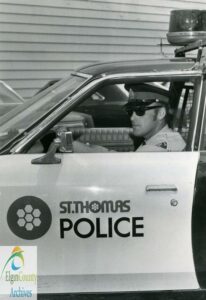 began to emerge as early as the 1880’s. Chief Fewings outlined the qualifications of a Constable as possessing the general knowledge of police duties, an able body, be no shorter than 5’10” in stature, good tempered, and be able to pass examinations in reading, writing and arithmetic. He stated that “a quiet, determined manner will induce by-standers to assist” and that reading, writing and general improvement of “his” mind was important for promotion. Of course, back then, women did not yet serve as police officers. By the 1970’s, the Police Act required an officer to have a minimum grade 10 education. Prior to this, the majority of the members of the force met the minimum standard and few had graduated from grade 12. In the sixties and early seventies, hiring was still largely based on size and strength, courage, honesty and tenacity. The late seventies brought a change to recruiting priorities with an emphasis on education and physical fitness. Today’s minimum standard for education is the completion of high school but current applicants – male and female – have graduated from either College and/or University and also serve their community in a variety of volunteer positions. Applicants are in excellent physical and mental condition due to a lifestyle that emphasizes better eating habits, regular exercise and promotes good health and overall well-being.
began to emerge as early as the 1880’s. Chief Fewings outlined the qualifications of a Constable as possessing the general knowledge of police duties, an able body, be no shorter than 5’10” in stature, good tempered, and be able to pass examinations in reading, writing and arithmetic. He stated that “a quiet, determined manner will induce by-standers to assist” and that reading, writing and general improvement of “his” mind was important for promotion. Of course, back then, women did not yet serve as police officers. By the 1970’s, the Police Act required an officer to have a minimum grade 10 education. Prior to this, the majority of the members of the force met the minimum standard and few had graduated from grade 12. In the sixties and early seventies, hiring was still largely based on size and strength, courage, honesty and tenacity. The late seventies brought a change to recruiting priorities with an emphasis on education and physical fitness. Today’s minimum standard for education is the completion of high school but current applicants – male and female – have graduated from either College and/or University and also serve their community in a variety of volunteer positions. Applicants are in excellent physical and mental condition due to a lifestyle that emphasizes better eating habits, regular exercise and promotes good health and overall well-being.
Training for a Police Officer today differs drastically from the past. A generally accepted practice in the 1970’s was that formal training NOT be given a high priority. It was unusual for a constable to receive any formal police training at the Ontario Police College until well into his career. The priority given to training greatly increased the by early 1980’s and today, the members of the St. Thomas Police Service are some of the very best trained officers in Canada.
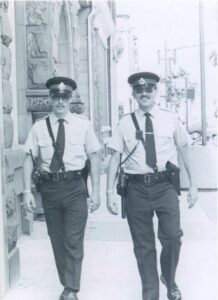 Today, the entry level position to become a Police Constable with the St. Thomas Police Service is the Police Cadet position. This valuable position provides the candidate with a variety of hands-on experiences to observe and learn about the constable position including communication and dispatching, exposure to the court system, report writing, serving court documents, and ride-along opportunities to experience the life of a constable on the streets. As vacancies arise in the Uniform division, police cadets attend the Ontario Police College for Basic Constable training where they learn the duties and expectations of the profession through a Learning Management System. Their equipment includes not only handcuffs, a handgun and other use of force options but also a laptop computer to facilitate access to training materials. Upon successful completion of the program, the cadet is sworn in as a Police Constable. The career of a Police Constable requires on-going training in a myriad of areas, continued formal education and annual re-qualifications including use of force training, firearms, CPR and first aid as well as specialized continuing education in police courses such as forensic identification, breathalyzer technician training, accident reconstruction and traffic enforcement and criminal investigation, to name a few. Officers continue their education throughout their career based on their interests, assignments and promotions. Today, the attainment of knowledge becomes a career-long quest that will assist an officer in making confident decisions and acting competently in the performance of his or her duties.
Today, the entry level position to become a Police Constable with the St. Thomas Police Service is the Police Cadet position. This valuable position provides the candidate with a variety of hands-on experiences to observe and learn about the constable position including communication and dispatching, exposure to the court system, report writing, serving court documents, and ride-along opportunities to experience the life of a constable on the streets. As vacancies arise in the Uniform division, police cadets attend the Ontario Police College for Basic Constable training where they learn the duties and expectations of the profession through a Learning Management System. Their equipment includes not only handcuffs, a handgun and other use of force options but also a laptop computer to facilitate access to training materials. Upon successful completion of the program, the cadet is sworn in as a Police Constable. The career of a Police Constable requires on-going training in a myriad of areas, continued formal education and annual re-qualifications including use of force training, firearms, CPR and first aid as well as specialized continuing education in police courses such as forensic identification, breathalyzer technician training, accident reconstruction and traffic enforcement and criminal investigation, to name a few. Officers continue their education throughout their career based on their interests, assignments and promotions. Today, the attainment of knowledge becomes a career-long quest that will assist an officer in making confident decisions and acting competently in the performance of his or her duties.
Today, physical strength and stature are no longer criteria for hiring officers. Religion, gender, race, sexual orientation and marital status are no longer considerations in hiring practices. Selection processes are inclusive, embrace diversity and better reflect the demographics of the community served. The first female member of the Police Service joined in 1918. Mrs. Annie Taylor served as a civilian matron for the cells and her purpose was to search female prisoners. She was paid an annual salary of $25.00. A police Constable was paid $960 a year. For decades, the only females employed by the Police Service were civilian matrons, clerks, dispatchers and secretaries. The record books indicate that several attempts were made during the 1940’s to demonstrate the need for female police officers. The Home and School Committee of the Women’s League in 1942 submitted a proposal to the Commission of the day outlining the advantages of a women serving as a police officer, but the motion was defeated. It was not until 1986 that our first female police officer – Laurie Ewing – was hired. She was promoted through the ranks of our Service and the London Police, eventually retiring as Chief of the Strathroy Police Service.
The introduction of Employment Equity legislation in the late 1980’s – early 1990’s resulted in the hiring of more female and visible minority officers than at any other time in our history. Today, our Police Service is more reflective of our community and of the era in which we live. In 2002, two female Sergeants, eight female Constables, and fourteen female Civilians served on the Force. In 1999, Judy Kowalczyk became the first female Sergeant to be assigned to supervise a specialized unit – Criminal Investigations Branch. She was eventually promoted to Staff Sergeant (the first female Staff Sergeant with our Service), retiring at that rank with 30 years of service. Since that time, several other female officers have been promoted to the rank of Sergeant and Staff Sergeant, serving as Patrol and Court Supervisors. Although the profession continues to be predominantly male, it may not be long before females reach the highest ranks of our organization as a result of the implementation of a highly competitive promotional process and equal opportunity to compete.
Equipment, budgets, salaries, transportation, communications, record management – the way our services are provided to our citizens – have changed drastically over the years. In the 1800’s, the annual operating budget was $1,750.00. Today’s budgets top $13 million. By 1898, the Force had increased by one Constable to a compliment of five. In addition, for special events, the City would hire special Constables at a rate of $1.50 a day to supplement the regular force. The clothing allowance for the winter of 1898 was $111.50. The Chief was allowed a $22.00 coat; the Sergeant wore a $20.00 coat and the Constables wore a $19.00 coat. By 1902, Constables earned $50.00 per month while the Sergeant earned $60.00. In the past, workdays and shifts were determined by seniority. The junior constable worked straight night shifts. The early 1930’s saw modernization in spite of the depression. Revolvers became standard equipment; the shorter six-day work week with two weeks of holidays and free uniforms were introduced by 1935 at which time the Force consisted of seven men. A patrol car was purchased in the late 1930’s but the Force remained at a sworn strength of 7-9 men. The Chief and one man were in the office, one was on his beat, and one was in the cruiser. As the patrol car did not yet have a radio, the Constable driving it had to go past the City Hall every 45 minutes. If the center blind in the southwest window was down in the daytime or if it was up at night, the Constable had to report in. The salary in 1933 was $100.00 per month for a constable based on a six-day workweek at ten hours per day. Due to the depression, City salaries were actually lower than in 1929 as a result of the hard times when all civic salaries were severely cut. In 1940, Constable Wilf Whiteman, who later became the Chief of Police, became the first member of the St. Thomas Police Force to be sent away for formal police training. In the 1940’s, patrol cars were finally equipped with radios. This was the beginning of a long series of technological improvements including “walkie-talkies”, telex machines and telephone communications.
By May of 1978, the compliment of the Force totaled 46 sworn members including 35 Constables, 8 Sergeants, one Staff Sergeant, a Deputy Chief and Chief Ted Cohoe. In addition, nine civilians were employed as Clerks and Radio Dispatchers. As a young constable, the opportunities within the organization were somewhat limited. In those days, a constable would be deployed on foot patrol for the first four or five years of their career and would occasionally be lucky enough to be given a cruiser if manpower shortages or workload necessitated the need to take a beat officer off the beat. Many retired officers would be able to recall longing for the day when they were “senior enough” to be assigned a cruiser on a regular basis. Even today, the beat is an excellent training ground for developing a young officer. Because a cruiser physically creates a barrier between an officer and the public, interaction with the public is limited. Such is not the case on the beat. A young officer soon learns that in order to deal effectively with the public, you need to learn to be able to talk on your feet. In the past, the weapon of the day was a “baton” or “night stick” which officers had to buy themselves. Today, officers are equipped with a variety of options such as OC spray, tasers, and pistols as well as training in empty-hand techniques and de-escalation methods.
By the 150th anniversary of the Service (2002), the compliment of our Police Service had grown to fiftyseven sworn members, thirteen civilian staff including four cadets and two Special Constables to provide services to the courts. Of those sworn members, ten were female members and one husband and wife team. Our Uniform Division consisted of four platoons with each platoon supervised by a Staff Sergeant in charge of the shift and a Sergeant who provided road supervision to our patrol officers. Each platoon had a police communicator who provided dispatch and telephone response duties. Today, the Platoon system continues to operate for the provision of front-line policing services as the initial responders to both emergency and non-emergency calls for service. Officers work 12 hours shifts – two-day and two-night rotations followed by four days off – with duties ranging from initial response, investigation, enforcement and a variety of patrols including vehicle, bicycle and foot patrol. Each Platoon now has dedicated full and part time Police Communicators who are the initial call takers who assess the needs of the caller and dispatch officers to respond appropriately to the situation. They provide assistance throughout each call so that the required information and necessary supports such as ambulances or fire rescue are notified. Each Platoon also has dedicated Police Cadets who are trained as Police Communicators. This experience allows the cadet to gain knowledge and expertise that will be invaluable in their future role as a Constable.
Since 2002, the Service continued to grow to meet the ever-changing needs of the flourishing community. With a population of more than 40,000 residents in St. Thomas in 2021, our Police Service has now grown to more than 100 staff members with 73 sworn members including 56 men and 18 women as well as 38 civilians including 26 women and 12 men. The range of salary for a 1st Class Constable is $100,000 – $110,000. The mode of transportation once consisting of only two bicycles and foot patrol has expanded to a fleet of well-equipped police cruisers, specialty vehicles and bicycles. City Planners forecast the population to reach 50,600 residents by 2041 and as such, the Police Service Administration and Board will continue to review the needs, hire and deploy staff and resources to not only meet but exceed the demands of the growing community.
Many years ago, the Police Constable was responsible for a call for service from start to finish – responding to the initial call, conducting the entire investigation, laying charges and attending court if necessary, to conviction or completion of the incident. They were not only first responders but also the traffic officers, detectives, and community resource officers. Over time, the Administration reviewed the demands on the front-line officers and established a variety of specialty units that could not only reduce the workload on the front-line officer but dedicate specially trained officers to further investigate more complicated cases. Policing evolved to be both reactive and proactive. These special units provide greater support to the front-line officer by focusing resources to better react to incidents as well as proactively respond to emerging issues in the community. Staff are now deployed to specialty units such as the Criminal Investigations Branch, Street Crimes, Criminal Intelligence, Canine Services, Forensic Identification, Technical Crimes, Traffic Enforcement, Crime Prevention, Community Engagement, Court Services and Crime Stoppers. Most recently, a Mobile Outreach Support Team (M.O.S.T) of specially trained mental health workers was created to attend calls with an officer dedicated to the team to address the ever-increasing mental health related calls for service. In the first six weeks, the team responded to nearly 200 calls to assist people in distress. The goal is to continue to reduce the number of apprehensions, provide supports and reduce the strain of mental health calls on policing and the court system.
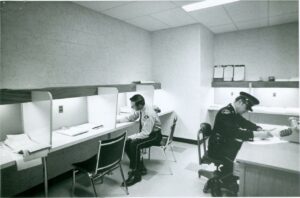 Today’s Criminal Investigation Branch is a specialized unit of highly trained investigators whose mandate is to investigate and help prosecute criminal matters of a more serious nature. Over the last few decades, these officers have investigated murders, attempted murders, suspicious deaths and suicides, child abuse cases, sexual assaults, major thefts, robberies, frauds, and arsons to name just a few types of incidents. Officers in the Street Crimes unit in conjunction with the Intelligence unit gather information from many confidential informants and front-line officers to develop leads that often result in the execution of search warrants and arrests of participants in the drug culture in our community. Forensic Identification officers assist investigators at crime scenes by searching for and retrieving relevant physical evidence for forensic analysis. In many cases today, the use of DNA collection and identification is an investigative tool that helps to identify a suspect in an investigation where there are no other leads. DNA examination and results have been used to not only identify suspects but to convict them of the crime(s). A new investigative tool emerging is forensic genealogy that utilizes genetic information to identify suspects or victims in criminal cases. This is possible through the analysis of identity by descent segments of DNA that indicated shared ancestors.
Today’s Criminal Investigation Branch is a specialized unit of highly trained investigators whose mandate is to investigate and help prosecute criminal matters of a more serious nature. Over the last few decades, these officers have investigated murders, attempted murders, suspicious deaths and suicides, child abuse cases, sexual assaults, major thefts, robberies, frauds, and arsons to name just a few types of incidents. Officers in the Street Crimes unit in conjunction with the Intelligence unit gather information from many confidential informants and front-line officers to develop leads that often result in the execution of search warrants and arrests of participants in the drug culture in our community. Forensic Identification officers assist investigators at crime scenes by searching for and retrieving relevant physical evidence for forensic analysis. In many cases today, the use of DNA collection and identification is an investigative tool that helps to identify a suspect in an investigation where there are no other leads. DNA examination and results have been used to not only identify suspects but to convict them of the crime(s). A new investigative tool emerging is forensic genealogy that utilizes genetic information to identify suspects or victims in criminal cases. This is possible through the analysis of identity by descent segments of DNA that indicated shared ancestors.

In 2013, the St. Thomas Police Service formed the first ever Canine unit as part of the Criminal Investigations Branch. Constable Sean James and the first dog, Trax, a purebred German Shepard from the Czech Republic, completed training with the London Police Servic e and commenced their tour of duty. The Canine unit supports the front -line officers by searching for evidence, tracking missing persons and suspects of crime, participates in drug searches and public events. Trax was forced to give up his career after only 3.5 years due to the incurable diagnosis of gracillis myophathy, the hardening of the muscle causing restricted movement. Our second Police dog, Axle, a Belgian Malinois from Michigan proved to be a quick learner and became the perfect partner for Canine handler, Constable James. Through generous donations from local business and community members, the Service continues to provide and maintain a K-9 unit to serve the citizens of St. Thomas.
In order to keep up with the fast-paced, ever-changing world of technology, our Police Service initially relied on the computer expertise of officers who had an interest in information technology. For many years, Inspector Bob Dymock provided the necessary supports for the emerging computer systems; Staff Sergeant Russ Yates followed in his steps and took the Service to the next level of computer expertise. Eventually, it became too much for one person who also had police duties, so the Information Technology Unit was created. Today, the unit has several full-time civilian specialists working to address the ongoing IT needs of the Service. The Police Service, expanding into the digital world, has now established a position for a Technical Crime Analyst to assist with investigations involving computer technology to gather, examine and analyze electronic data for the purpose of developing, enhancing and clarifying evidence from all types of digital devices. The proliferation of various cybercrimes is an emerging concern and policing in our community can now better address, investigate and protect our citizens.
The Support Services component of the Service previously included three officers assigned to court services: one Community Service officer, one Crime Prevention officer and one Community Resource officer. Their focus was proactive – community education. The Community Service Officer assigned to the local elementary schools provided programs designed to address topics such as street and bicycle safety, stranger awareness, bullying, shoplifting, drug awareness and anti-violence. The Community Resource officer enhanced the Adopt-A-School program and our beat patrol program. Like the Community Service officer, the Crime Prevention officer focused on education and the prevention of crime. Many programs such as Neighbourhood Watch, Variety Store Watch, Hospital Watch, Block parents, anti-shoplifting, robbery prevention, STEP – or Seniors Taking Extra Precautions, and a variety of other programs aimed at raising public awareness to assist in preventing crime. As well, trauma counseling and victim’s assistance programs were made available through the cooperation with various agencies within the City. In the late 90’s, a new program called the “Most Wanted Crusaders” program was started in our community. Its purpose was to enhance already existing community service and crime prevention programs by increasing our presence in the community and making police officers more approachable, especially to our youth. The Most Wanted Crusader program emphasized the need for the police and the public to work together and with this program, youth in the community were encouraged to be crusaders against crime, crusaders against drugs, crusaders against theft. The support for this initiative was overwhelming from the financial assistance provided by many local businesses to the response from the children, teens and adults in the community. This is but one example of the excellent community support the Police enjoy within this community.
Our Police Service is fortunate to have tremendous community support. Our involvement with the community in proactive efforts started many, many years ago by Constable Hank Davie – our first Safety officer, and Community service/Crime Prevention officer, Constable Larry Rabbitts. Expanding on the efforts of Constable Davie, Constable Rabbitts spent many years working with the schools, the businesses and the various community groups establishing many of the partnerships, programs and services offered today.
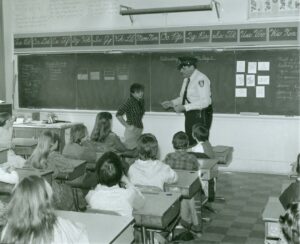 In January 2000, in an effort to enhance and continue the positive relationships established at the elementary school level by our past and present community service officers, an Adopt – A- School program was introduced to the high schools. This program involves officers who have volunteered for the assignment to attend their “adopted” high school and to interact on an informal basis with students and staff. This non-confrontational interaction promotes positive relationships between the students, teachers, parents, and police. This program received positive feedback from the entire school community. It is not uncommon to see police officers walking the halls of our high schools, participating in sporting events or graduation ceremonies, attending school council and parent/teacher meetings or providing lectures to classes on a variety of legal issues, drug or alcohol abuse or on policing as a profession. Today, our Community Engagement unit continue the efforts of the past to engage youth in meaningful dialogue and mentorship. In the elementary schools from Junior Kindergarten to Grade 8, topics such as bullying, drug awareness, proper use of 911, internet safety, sexting, bicycle and pedestrian safety are discussed. Communication also promotes community involvement in crime prevention programs and expands our educational initiatives including Robbery Prevention, Frauds and Scams, Elder Abuse, and Crime Prevention Through Environmental Design. Our School Resources officer continues to build positive relationships between Police and young people enrolled in Grades nine to twelve speaking about topics such as Impaired Driving, Dangers of Illicit Drugs, Policing as a Career and Responsible Social Media Use. In the high schools, the mandate is to enhance communication between school officials, students, parents, and the police. Our Community Services officer is a visible and dedicated police presence in the downtown core with the priority of enhancing public safety and strengthen community partnerships. The St. Thomas Police Service continues to advocate proactive policing and actively promotes the concepts of community involvement. By maintaining effective, open lines of communication between the Police Service and our citizens, we are able to better inform the public about timely issues of concern in our community.
In January 2000, in an effort to enhance and continue the positive relationships established at the elementary school level by our past and present community service officers, an Adopt – A- School program was introduced to the high schools. This program involves officers who have volunteered for the assignment to attend their “adopted” high school and to interact on an informal basis with students and staff. This non-confrontational interaction promotes positive relationships between the students, teachers, parents, and police. This program received positive feedback from the entire school community. It is not uncommon to see police officers walking the halls of our high schools, participating in sporting events or graduation ceremonies, attending school council and parent/teacher meetings or providing lectures to classes on a variety of legal issues, drug or alcohol abuse or on policing as a profession. Today, our Community Engagement unit continue the efforts of the past to engage youth in meaningful dialogue and mentorship. In the elementary schools from Junior Kindergarten to Grade 8, topics such as bullying, drug awareness, proper use of 911, internet safety, sexting, bicycle and pedestrian safety are discussed. Communication also promotes community involvement in crime prevention programs and expands our educational initiatives including Robbery Prevention, Frauds and Scams, Elder Abuse, and Crime Prevention Through Environmental Design. Our School Resources officer continues to build positive relationships between Police and young people enrolled in Grades nine to twelve speaking about topics such as Impaired Driving, Dangers of Illicit Drugs, Policing as a Career and Responsible Social Media Use. In the high schools, the mandate is to enhance communication between school officials, students, parents, and the police. Our Community Services officer is a visible and dedicated police presence in the downtown core with the priority of enhancing public safety and strengthen community partnerships. The St. Thomas Police Service continues to advocate proactive policing and actively promotes the concepts of community involvement. By maintaining effective, open lines of communication between the Police Service and our citizens, we are able to better inform the public about timely issues of concern in our community.
Another significant impact on policing over the last forty years has resulted from the tremendous technological changes that we have experienced. From the days of telex machines and party line telephone systems, we advanced to an era where state of the art communications included radios, telephones, cell phones, pagers, fax machines, computer systems, the internet, etc. allowing us to communicate and share information with other agencies. In the late 1980’s, PC Cops became the St. Thomas Police Service’s first computerized system that allowed us to electronically contact citizens with programmed messages about ongoing criminal activities in specified areas of the City and provided crime prevention tips to help citizens avoid being victimized. By the end of the 80’s, our first Crime Stoppers program ushered in the next decade with a new alternative to anonymously report criminal activities, creating a whole new world of informants for police.
Improvements to Police radio equipment allowed communications with all police agencies within the Province; computer systems link us locally, provincially, nationally and internationally. Today, information is available and exchanged unlike any other time in history. This increased knowledge and communication capability allows today’s officer to link similar incidents and track down criminal activity far more efficiently than ever before. New technology has changed how we communicate. It allows us to quickly share information. It impacts how staff are trained and influences the engagement of our citizens as partners in crime reporting and prevention. It has created efficiencies. The IT revolution has made technology an important investigative tool, helping us solve and prevent criminal activity. In many ways, it enhances the way the St. Thomas Police Service serves its citizens. In the past, officers needed to be persuasive in a quiet, determined manner, street wise and able to carry on a conversation with people from any walk of life. In the days before police cruisers, a beat patrol officer’s daily assignment afforded the opportunity to walk the streets and back alleys, talk to citizens and business owners and develop relationships and important informants through personal contact. They enjoyed a “comradery” with citizens. Today, communication has changed drastically. Officers created new ways of connecting with citizens and developing informants. In addition, a dedicated Corporate Communications Coordinator position was introduced in 2019 to be the verbal, visual and digital voice of the Police Service. Utilizing social media, the world wide web, television and radio, the Communications Coordinator ensures that the citizens receive accurate and timely information about important issues affecting the community. Furthermore, the Administration of the Service, in particular the Chief and Deputy Chief, utilize social media to engage with the community. Today’s Chief, Chris Herridge is a prolific user of Twitter and Facebook to respond to questions and personally engages with the community.
Technology changed everything and continues to change the delivery of policing services. Today’s patrol vehicles are equipped with mobile data terminals first introduced in 2006. These computers put pertinent information at an officer’s fingertips, create efficiencies and enhance officer safety. Officers can run license plates and names, obtain photographs to confirm identity and access vital information to assist in their encounters and investigations. Technology provides officers with information about high-risk offenders prior to their encounters so they are aware on any increased potential for conflict. It also prevents the interception of radio transmissions that could tip off a criminal about an active investigation. Gone are the days of radio scanners where the general public, including criminals, could listen to police communications. SPARK allows communication staff and front -line officers to privately communicate without interception by criminals. CAD, a Computer Aided Dispatch system and the information available from all aspects of the Provincial NICHE record management and information system, influence and affect how officers are dispatched on calls. Certain information will trigger an upgraded response to a call for service as a direct result of readily available information. Information sharing between agencies has significantly improved as a result of technology including CPIC – the Canadian Police Information Center – a central police database of information in relation to people and property such as missing people, stolen vehicles, criminal record and wanted persons; Interpol – the International Criminal Police Organization – connecting our Service to an encrypted, internet based, worldwide communications network; ViClas – the Violent Crime Linkage Analysis system – a nationwide computer system that assists specially trained investigators to identify serial crimes and criminal by focusing on the linkages that exist among crimes committed by the same offender; Provincial and National Sex Offender registries; and CROMS – a collision reporting and occurrence management system to analyze our commission data and plan proactive road safety programs. Officers also use an ALPR – Automated License Plate Reader that quickly captures large volumes of license plate numbers and matches them to the Ministry database and/or CPIC alerting officers to stolen or expired plates, registered suspended drivers or plates related to active Amber Alerts. By 2021, the City of St. Thomas, in partnership with the Downtown Development Board and the St. Thomas Police Service implemented a Closed-Circuit Television Camera surveillance project and initially, three cameras now operate at Hiawatha, Moore and Ross Streets. The CCTV system is a proactive, local solution modeled on successful networks in other municipalities to assist with solving and preventing crime and enhances the safety of the residents, businesses and visitors in our downtown core.
In 2018, the Global Positioning System or GPS technology was added to the fleet of vehicles to assist with both officer and community safety. Utilized primarily as a tool for tracking and monitoring the operation of all police vehicles in the fleet, GPS technology allows us to protect our most valuable asset – the front-line officer. GPS technology allows dispatch and command staff to know where an officer is located during a crisis and how close additional resources are to assist in the incident. GPS based fleet management can also provide information on patrol patterns and aid in the deployment of resources. In 2021, a more robust, enhanced GPS system along with changes from E911 to NG 911 technology, will assist with transitioning technological advancements by providing better location information, improved interoperability with other agencies, enhance call processing and improve infrastructure resiliency. Tracking technology like GPS will continue to provide important information to police and continue to contribute to improving the efficient delivery of police services in our community.
Technology has also completely changed the Business Office from the days of the telex machine and party line telephone systems, electric typewriters, fax machines and photocopiers to an era of SCOPE – a record management system that provides electronic disclosure to the Crown Attorney and Court Services to access all relevant information for court proceedings; and LiveScan – a electronic fingerprint system that allows office staff and officers to efficiently complete fingerprinting for both criminal submission and for the general public needing record checks for volunteering in the community or for employment purposes. An enormous variety of statistical information and analytical reports are now readily available without hours of compilation and report writing. It is certainly true to say that the realization of affordable technology has immeasurably changed policing and the delivery of services in our community. Rapidly changing technology will continue to impact our Police Service and transform the delivery of services in our community for decades to come.
As policing continues on this journey of transformation, current issues like mental health, poverty, homelessness, substance abuse and addictions increase demands on our Police Service. Images of police violence shown in the news and online have fueled calls to “defund the police” and undermined people’s trust and confidence in the police in general and our justice system. As such, new strategies for building trust with vulnerable communities such as immigrants, people of colour, people with disabilities, the LGBTQ community and all citizens are emerging. In 2018, the St. Thomas Police Service raised the PRIDE flag for the first time ever to show our solidarity within our community and a symbol of hope and acceptance. Internally, our first dedicated Diversity, Equity and Inclusivity unit was created to enhance the efforts locally in these areas. In an effort to improve transparency and accountability in police interactions with the public, the need to move forward with measures like body cameras is being explored locally and across the country. While advocates and policy experts have mixed reviews about how effective this tool will be, many believe it will provide an additional account of how events transpired, better protect officers from false accusations and help improve public trust.
In 2018, the St. Thomas Police Service spearheaded a new initiative called the “Elgin St Thomas Situation Table” whereby community partners joined together as a strategic alliance of human services with a common goal of mitigating situations in the community with vulnerable people by proactively identifying and connecting them to services before they experience negative or traumatic events. This group provides clear supports by connecting marginalized people to local services with the ultimate goal of not only providing the individual with resources and support but also reducing the continued need for police intervention.
Police officers regularly deal with the most violent members of society, put their live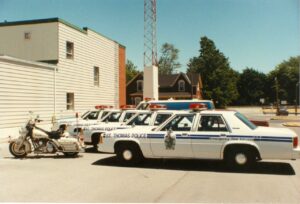 s on the line and confront cruelties and horrors that most of us only view while reading newspapers or computer screens. At some point in their careers, officers experience traumatic incidents such as a gruesome motor vehicle collision, homicide, a vicious crime against a child, a shooting and suicides. In addition, officers are also frequently the target of criticism and complaints by citizens and the media. The increased demands and challenges facing policing today have certainly had a profound impact on the health and well-being of today’s Police officer. In the past, officers were expected to suck it up and move on, to bottle up their feelings and as a result, were reluctant to talk about the trauma they experienced. Today, the very real result of these encounters that can impair the mental well-being of officers and affect their ability to perform their duties is now identified as Post Traumatic Stress Disorder. It is now recognized that the potential long-term effects of PTSD can lead to behavioral disfunction, substance abuse, aggression and suicide if left unchecked. As a result, many initiatives have been implemented including PTSD awareness training, proactive assessment and debriefing after traumatic incidents, and psychological supports. In 2017, the St. Thomas Police Service introduced a Peer Support/Critical Incident Stress Management team with the intention of supporting officers and members of the Service who experience critical incidents, stressful situations or cumulative stressful situations, both personal and work related. The goal of the peer support team is to provide officers with emotional and tangible supports in a time of crisis. It provides a venue where they can openly share their experiences and pain with trusted fellow officers who are perhaps best able to relate to their colleagues’ experiences in the line of duty and who have been trained to handle the conversations and respond to different scenarios. The Peer Support team can act as one facet of treatment along with professional counseling and medical treatment. Today, wellness isn’t just about mental health. A variety of improvements are now available to officers and police staff such as fitness facilities in our new police headquarters, Chaplaincy services, self-assessment surveys, and a variety of wellness initiatives and programs promoting physical, emotional and psychological health. In 2020, the Association office was modified into a Wellness Room for members where they can speak privately with a peer or rest in peace after experiencing a traumatic event. Wellness touches every aspect of life – physical health, personal relationships, financial security, community and career. Today, it is imperative for leaders to take care of employees, to strengthen and protect employee well-being which, in turn, will cultivate resilience, improve performance and encourage engagement for the future.
s on the line and confront cruelties and horrors that most of us only view while reading newspapers or computer screens. At some point in their careers, officers experience traumatic incidents such as a gruesome motor vehicle collision, homicide, a vicious crime against a child, a shooting and suicides. In addition, officers are also frequently the target of criticism and complaints by citizens and the media. The increased demands and challenges facing policing today have certainly had a profound impact on the health and well-being of today’s Police officer. In the past, officers were expected to suck it up and move on, to bottle up their feelings and as a result, were reluctant to talk about the trauma they experienced. Today, the very real result of these encounters that can impair the mental well-being of officers and affect their ability to perform their duties is now identified as Post Traumatic Stress Disorder. It is now recognized that the potential long-term effects of PTSD can lead to behavioral disfunction, substance abuse, aggression and suicide if left unchecked. As a result, many initiatives have been implemented including PTSD awareness training, proactive assessment and debriefing after traumatic incidents, and psychological supports. In 2017, the St. Thomas Police Service introduced a Peer Support/Critical Incident Stress Management team with the intention of supporting officers and members of the Service who experience critical incidents, stressful situations or cumulative stressful situations, both personal and work related. The goal of the peer support team is to provide officers with emotional and tangible supports in a time of crisis. It provides a venue where they can openly share their experiences and pain with trusted fellow officers who are perhaps best able to relate to their colleagues’ experiences in the line of duty and who have been trained to handle the conversations and respond to different scenarios. The Peer Support team can act as one facet of treatment along with professional counseling and medical treatment. Today, wellness isn’t just about mental health. A variety of improvements are now available to officers and police staff such as fitness facilities in our new police headquarters, Chaplaincy services, self-assessment surveys, and a variety of wellness initiatives and programs promoting physical, emotional and psychological health. In 2020, the Association office was modified into a Wellness Room for members where they can speak privately with a peer or rest in peace after experiencing a traumatic event. Wellness touches every aspect of life – physical health, personal relationships, financial security, community and career. Today, it is imperative for leaders to take care of employees, to strengthen and protect employee well-being which, in turn, will cultivate resilience, improve performance and encourage engagement for the future.
In accordance with the Police Act of Ontario, it is the responsibility of the Municipality to provide all infrastructure including an appropriate facility for the Police Service. The Police Service, once housed in the basement of the current City Hall, eventually expanded to the point that the municipality agreed to build a separate facility for the Police. Construction of the Colin McGregor Justice Building (named to honour the only officer killed in the line of duty) started in 1970 and the multi-use building opened in 1971, housing both the Police Service and the Court facilities. At that time, the Police Force was comprised of 35 members including sworn and civilian staff. By the early 1980’s, it was apparent that the Police Force was quickly outgrowing the Justice Building. For the next few decades, a number of groups including the Court House User Committee, the Superbuild Feasibility Study Group, the Task Force on Courthouse Facilities along with the Administration and Police Commission discussed the inadequacies and potential solutions. Ministry inspections highlighted the need for a new facility. As early as the1980’s, Chief Wayne Howard and the Police Commission wrote letters of concern to consecutive City Councils. By 2003, the City commissioned a study by The Stonewell Group who reported that the space was insufficient for the immediate and future needs of the Police Service and recommended the construction and occupancy of a centralized, single facility for the Police Service. By December 2007, the search for property to build a new Police Headquarters was underway. Over the next few months, submissions from property owners were received and although several sites received consideration, it was not until September 2011 that City Council announced the purchase of the land beside the Timken Center (as it was named in 2011). For the duration of Chief Wayne Howard’s tenure (1987-1998) followed by Chief Bill Lynch’s tenure (1998- 2013), the Administration and Police Services Boards worked tirelessly on the plans to bring the construction of the new Police Headquarters to fruition. In 2011, the construction of the new courthouse began on Wellington Street and by March 2014, the Courts moved from 30 St. Catherine Street to the new Elgin Country Courthouse. During Chief Darryl Pinnell’s tenure (2013-2017), M.J. Dixon Construction commenced construction of the new police facility (2015) including the extension of Third Avenue to Talbot Street (now CASO Crossing) all of which was completed by July 2017 at a cost of $10.9 million dollars. The facility is a two-storey (main floor and basement) building with approximately 44,000 square feet of space including significant unfinished space in the basement for future expansion. The building includes exterior parking facilities, state of the art sally port, booking and prisoner processing areas and cells, video interview rooms, Communications center, property and evidence rooms, forensic identification labs, canine areas, conference and board rooms, locker rooms, fitness facilities and on-site training rooms. In 2018, the Justice Building at 30 St Catherine Street was deemed unsuitable for occupancy and demolished to make way for a future community park. The new home of the St. Thomas Police Service, centrally located in the downtown core of St. Thomas adjacent to the existing Elgin County Railway Museum and the Joe Thornton Community Center, will benefit the members of the Service and the City of St. Thomas for decades to come as our community continues to grow and prosper.
We are proud of our history and will continue the tradition of providing the highest level of professional, effective and economical police services to the citizens of St. Thomas for centuries to come. Our Police Service will continue to examine alternative and innovative means to provide cost effective and efficient policing services. We will remain progressive to ensure our members have sufficient staffing, current training, access to modern resources and health supports to enhance their well-being so that they may continue to serve with commitment and integrity. We will continue to engage our community and forge partnerships with citizens and organizations so that together, St. Thomas will continue to meet future challenges with creativity and innovation.

IN MEMORIAL

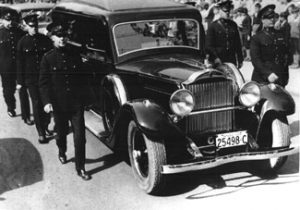
In 1852, the Village of St. Thomas appointed its first Constables. Since then, one police officer has been killed in the line of duty.
On Monday, May 7, 1934, Colin Clair McGregor, age 28 years, was shot while attempting to execute a warrant for the theft of a bicycle at 17 Queen Street in St. Thomas. Constable McGregor subsequently died of his injuries at Memorial Hospital, leaving behind his wife, Muriel (23 years) and two young sons, Raymond Edward and Colin Wayne.
Funeral services were held on Thursday, May 10, 1934 at 2:00 p.m. at P.R. Williams & Son funeral home and Colin McGregor was laid to rest at the St. Thomas Cemetery. It was reported that this was the largest funeral ever accorded anyone in the City. The route of the funeral was lined with hundreds for whom there was no accommodation at the funeral home and hundreds more waited at the cemetery for the service there. An honour guard of officers marched with the coffin carried by pallbearers – Constable Thomas Ryckwood, Constable Harry McCart, Constable George McIntyre of the St. Thomas Police Department and Constable Harry Noakes, Constable Rex Caverley and Constable McBride of the Ontario Provincial Police. Honourary bearers were Judge D.C. Ross, Mayor Angus W. Johnson, Police Magistrate, C.F. Maxwell and Chief of Police William M. Ketchabaw.
Chiefs of Police and officers from Chatham, Paris, Brantford, Hamilton, Tillsonburg, London, Toronto, Niagara Falls, Windsor, Sarnia, the RCMP and the OPP attended the service. Tributes were received from relatives, friends, colleagues and representatives of government, businesses and other emergency services from across the province.
Fred Temple (21 years) and his father, Frank, were arrested and charged with the murder of Colin McGregor. At their trial, the father and son were found guilty and were subsequently hanged in a double execution on June 27 in the yard of the Elgin County courthouse.
A plaque honouring our fallen hero, Constable Colin C. McGregor, adorns the front lobby of our Police Headquarters. A City street was named in his honour in 1992 and to the present day, the Colin C. McGregor Memorial Scholarship to the University of Western Ontario is awarded annually to deserving students.
LET US NEVER FORGET
RELATED LINKS:
Ontario Police Memorial – Canada: https://www.opmf.ca/control.php?p=main
